OFF-TOPIC (37)
By:
February 28, 2022
Off-Topic brings you over-the-transom, on-tangent essays, dialogues and subjective scholarship on an occasional, impulsive basis. To jump off into a new year of persistence and potential from the edge of Black History Month 2022, this latest deep dive through the comics-pile and academic archives of pop refuge and resistance…
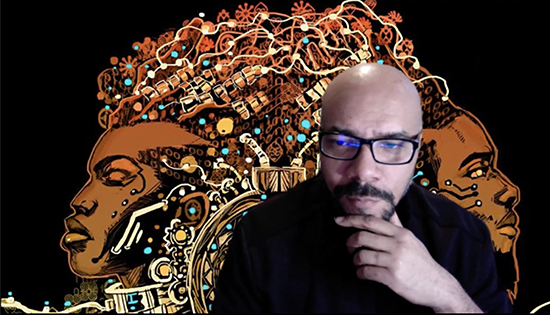
What if all your dreams were true to begin with, and you just didn’t remember any of them? Ideals deferred, effaced, denied, forgotten, are the psychic territories defended in the Afrofuturist fables of John Jennings and his collaborators. Roads not traveled but there for the taking are traced through the tangle of what should have been, in Jennings’ reclamations of obscured Black sci-fi and comics creators, remixes of favorite pop concepts from a palette of broader cultural context, and contributions as both originator and adapter of new (or resumed) universes of Black experience, vision and possibility.
A regular to this column (e.g., here, here and here), Jennings is known widely as one half (with co-artist Stacey Robinson) of the Black Kirby project, a series of images and exhibitions crosswiring Jack Kirby’s ethnic-ghetto-born dreams of cosmic transcendence with the mythic realism of Sun Ra and Parliament-Funkadelic and the metaphysical traditions that crossed the Middle Passage for a hybrid pantheon of galactic divinities. He’s also known as the curator of Abrams ComicArts’ MEGASCOPE imprint (named for an omniscient device imagined by W. E. B. Du Bois), committed to bringing signal works of Black sci-fi and horror to the graphic novel form, or bringing their authors to the medium for entirely new stories that push its possibilities. The same guy has also won two Eisners (comicbooks’ Oscar), one for co-editing a scholarly tome on Black identities in sequential art, the next for his and writer Damian Duffy’s adaptation of Octavia E. Butler’s Kindred, as well as a Hugo (science fiction’s Oscar) for his and Duffy’s adaptation of Butler’s Parable of the Sower.
Jennings co-founded three yearly conventions focused on the theory and joy of comics by artists of color (in New York, Ohio and San Francisco), and is in the vanguard of comics which themselves bridge the academy and the agora, with grant-funded graphic works for use by faculty and students as both exemplar and investigation of what pop folklore can communicate.
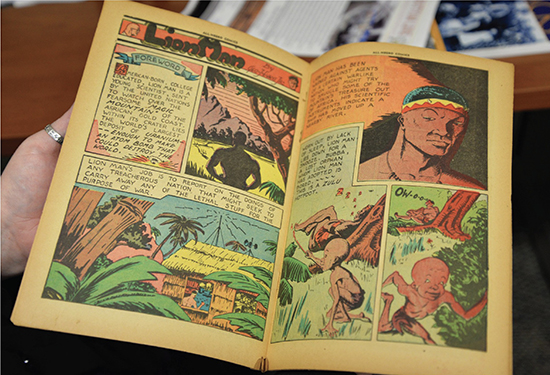
One of the most recent of these (a narrative experiment presented for St. Cloud State University in Minnesota) focused on the fictional figure believed to be the first Black superhero, Lion Man, who headlined the single published issue of the Black-owned and produced All-Negro Comics out of Philadelphia in 1947. Fleshed out to archetypal dimensions by Jennings and artist/co-storyteller David Brame, the 36-page story has epic breadth, true to the subjective time of the dreamscape it depicts, a masterful weave of historic referents and novel thematic free-associations.
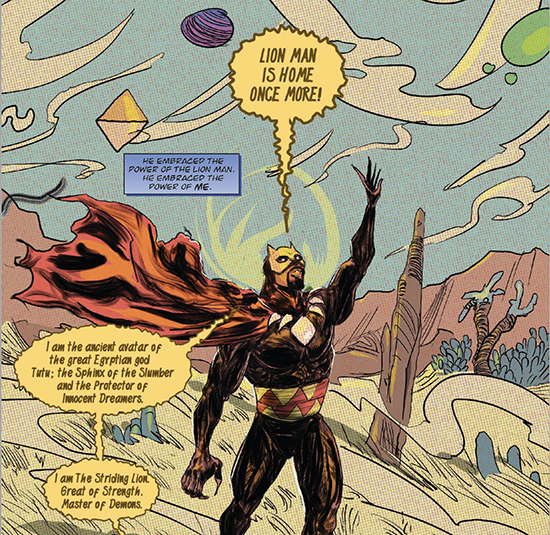
Picturing a technologically induced vision quest to reconnect to lost childhood and repair collective cultural memory, the story led Jennings into contact with an online community of enthusiasts for the vast annals of vintage pulp and comic characters who have fallen into public domain like Lion Man, and in his downtime (ha!) he began to brainstorm redesigns and backstories for a legion of heroes, villains and many in-between as they might look by now (and in different eras leading up to it) had they continued being published and morphed to meet contemporary measures of inclusiveness.
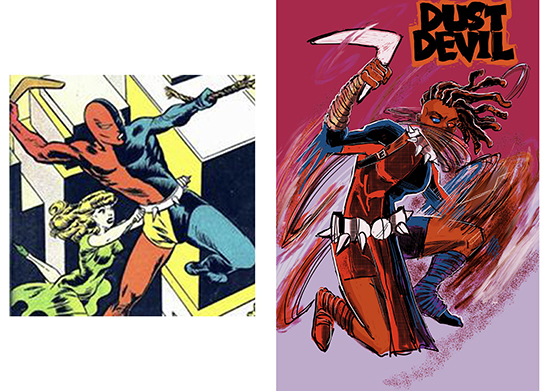
On a break in his teaching schedule as a Professor of Media and Cultural Studies at UC Riverside (yep, that too) we met to talk over the canon of Black fantasies and futures that never were and are yet to be…
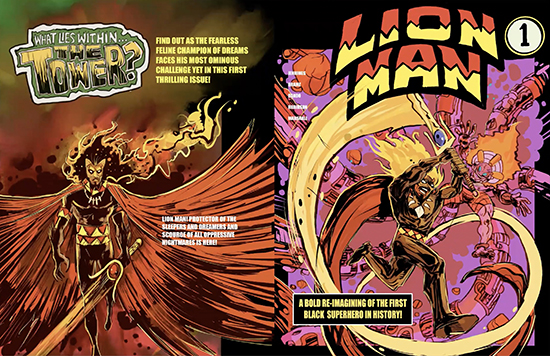
HILOBROW: What was the nature of the Lion Man grant, just to do culturally affirming narratives in any medium?
JENNINGS: Culturally affirming, using multiple ways of thinking about teaching in English and other Humanities spaces to kids and college students alike. [St. Cloud professor] Michael Dando managed to secure several grants including one from his own institution and also the United Way; we’ll be able to do a short comic every year.
HILOBROW: One of the many interesting things about it is it kind of re-implants characters like Lion Man into history, because now they are in a curriculum, which catches up on a few of the missed decades that they could have been in existence.
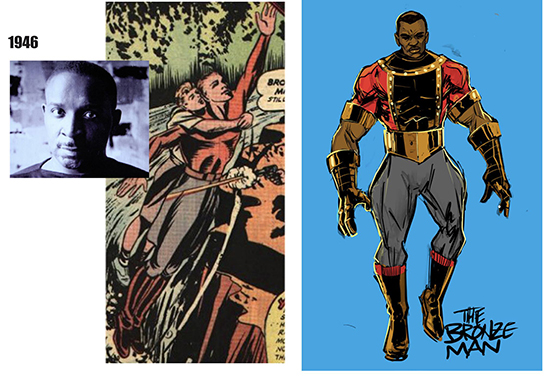
JENNINGS: I’ve been fascinated by the idea of it. A character like Bronze Man, who as far as we can tell, was supposed to be a Black character, and predates Lion Man by about a year. He probably would have been the first Black superhero, for real, if they had just let [creator] A. C. Hollingsworth do the kind of story he wanted to do.
HILOBROW: So Lion Man was just a small run, given out to students?
JENNINGS: The hardcopy was distributed to students, mostly the students that Michael was working with; like 400 copies, [which] we printed with Jason Reeves’ company, 133 Arts. Then what happened was Bill Campbell, over at Rosarium, he likes Lion Man so he wants to pull together a couple more stories and put it together as a trade.
HILOBROW: For a moment I was thinking maybe it would be cool if the book that comes out from Rosarium had one updated story for each of the characters from All-Negro Comics. Then it just occurred to me that [the star of Jennings’ occult noir book] Blue Hand Mojo could be like the scary modern update of [All-Negro hardboiled detective] Ace Harlem.
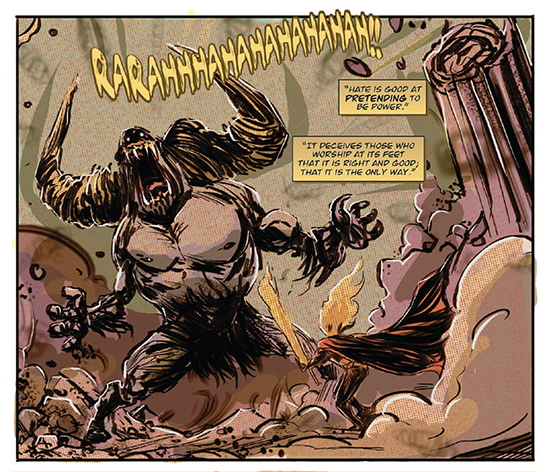
JENNINGS: It’s funny you should say, because when I looked at All-Negro Comics I thought, because I’m such a horror fan, I just started writing scary stories about all the characters. I wanna do a version of Lion Man where he actually is, like, a were-lion. And borrow from this ancient Egyptian god called Maahes. Maahes is a badass, he’s like a lion-headed god with a flaming sword, who fights against Apep, the serpent god who tries to eat the sun every day. So it’s got a really major antagonist, a badass god — it’s almost like Konshu from Moon Knight; that’s a… he’s very aggressive [laughs] and Maahes is like that too. And I was like wow, this would be a really cool opportunity to use Egyptian mythology, or mythology from someplace in Africa — but when I started thinking about it, Lion Man takes place in Ghana, which is a real place, with real legends; how do we get Maahes from Egypt to West Africa? I came up with an elaborate reason, but there’s actually an African god that’s a [full] lion that I can use for this. In the one you’ve read, I’m borrowing from — there’s this Egyptian god called Tutu, a sphinx character; and [together] they guard the subconscious, they basically are dream warriors. And fight against demons and nightmares, for people who can’t sleep.
But I have pretty cool working versions for all the All-Negro Comics characters in horror stories. You could almost write a horror version of Ace Harlem right from the get-go. Because there’s a hoodoo man in Ace Harlem…
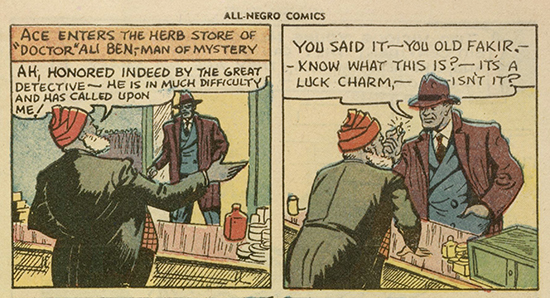
HILOBROW: Yeah, that local root-guy!
JENNINGS: So the local root guy becomes his mentor, and he becomes like a demon fighter. Because the two hoods that [die in the first story], they become zombies and they come back from the dead [laughs] — it writes itself!
HILOBROW: You’ve talked about envisioning the public domain characters as if they had continued to be published; I was thinking that Ace Harlem would be a sure bet to turn into more of a Batman type.
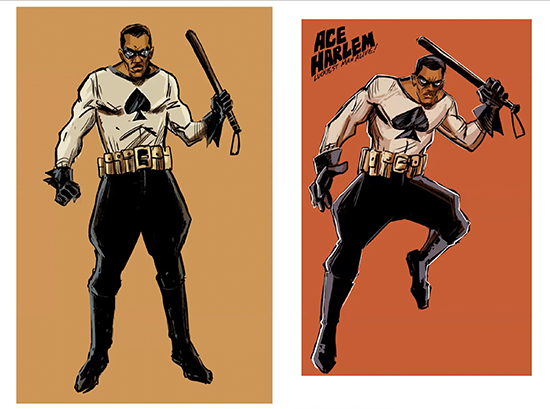
JENNINGS: Oh definitely. I have a version where the hoodoo man gives him a mojo bag and it allows him to not be hurt by bullets, and he becomes a costumed vigilante, “Ace Harlem, the Luckiest Man Alive.” I felt it was the next step for that character. I’m always thinking about, if this character really did [still] exist, they would have these different ages, they would go through these different social changes, and eventually, they might flip gender or race or sexual preference because of the times. How would they translate now, what would they become.
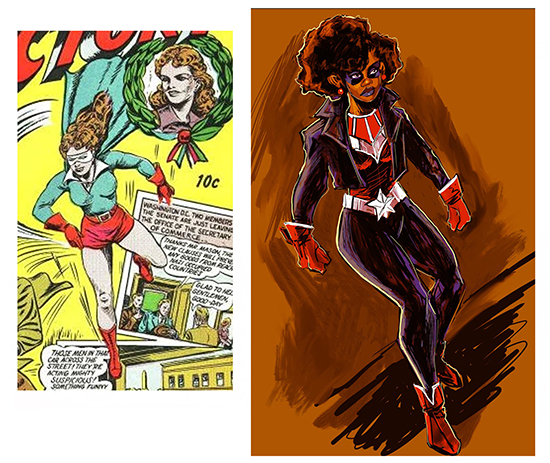
Then of course… I’m putting a team together [laughter]. I’m looking at a lot of the PD characters and thinking about their power sets. Essentially Miss Victory has Luke Cage’s power set. She’s very strong, and kind of indestructible. So I said, “Oh, well that’s Luke Cage.” So I made her into a Black woman called Lady Victory because I was trying to put together characters with power sets that matched mainstream Black characters. Taking on their aspects. So, the Purple Claw would be my John Stewart character; essentially it looks like an artifact that can do cool things —
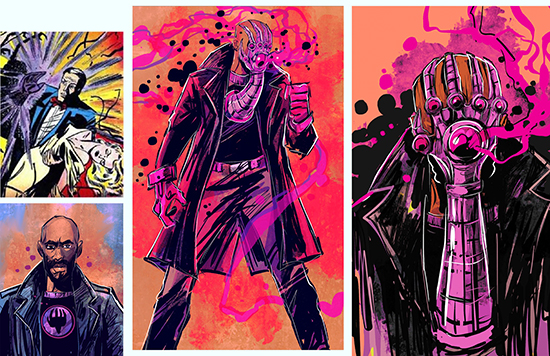
HILOBROW: — From the ring to the whole hand!
JENNINGS: Exactly. I thought about Diamond Jack as well — since he literally has a ring. A power ring, but more mystical; the jewel in it is actually the eye of some ancient god?!
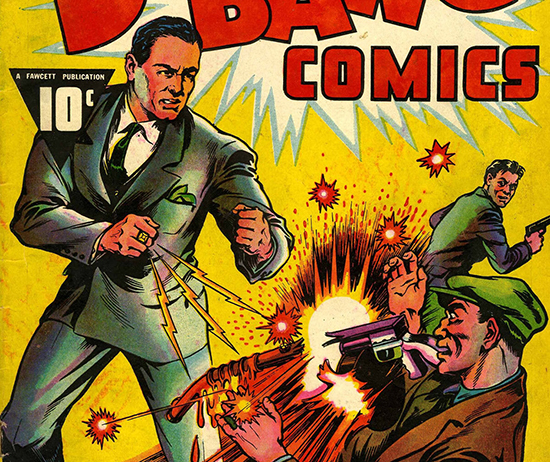
HILOBROW: You could get into some issues of colonial expropriation of mystic artifacts.
JENNINGS: Oh definitely. Someone posted potential African public domain characters on the “Public Domain HEROES” Facebook group, I guess they did it for Black History Month; I really appreciate it because I had never heard of — there’s so many characters on that database that I’d never heard of!
HILOBROW: I saw one of a shamanic figure outfitting this Tarzan-like hero with a magic cape?
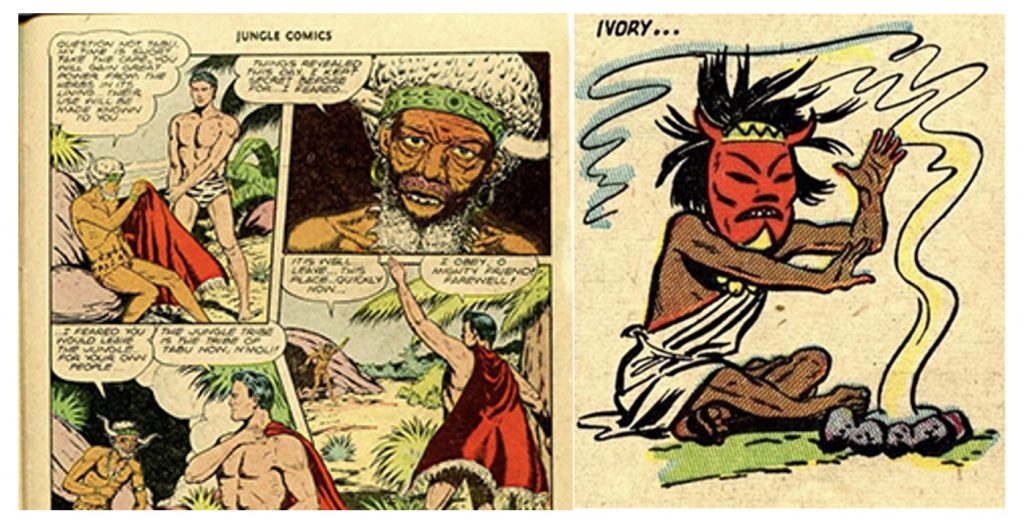
JENNINGS: N’moli! For Tabu. I was gonna call him Dr. Tabu — somebody else posted about Nyoko, this witch-doctor character. His name means “Elephant King,” and it was an anticolonial story — like a lot of these stories actually are, weirdly; anticolonial, anti-poaching, which I find really interesting. The character’s killed, he’s beaten to death, but then his spirit exacts revenge against the colonizers. But he uses this mask as part of his powers. So I thought, okay, I have this character who would wear this mask with the cape that Tabu had. Then I came up with this idea that the cape actually is an extension of this mystical cloth from Africa. That it actually grows according to what it’s needed for, it’s not just a certain amount of cloth. So you’d have this one piece of cloth that could give a lot of different people powers. For instance I have a version of The Woman in Red, I was thinking part of her cloak is maybe from this cloth.
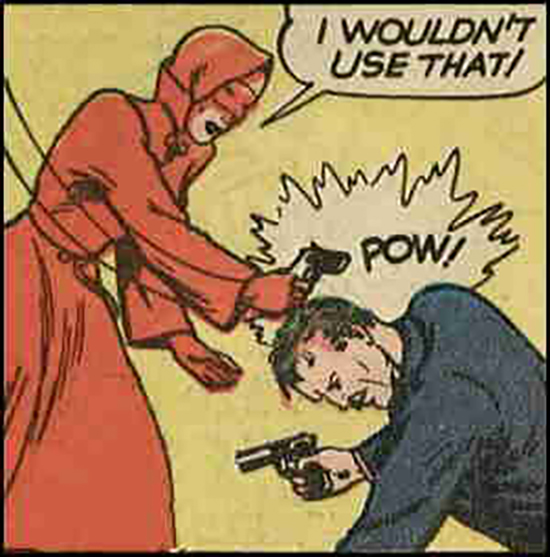
HILOBROW: That’s great, it can be like the textile vibranium of this universe!
JENNINGS: Thank you! That’s exactly… we should talk more [smiles]. Because I was thinking about, what would our vibranium be? So I have this idea — are you familiar with “The Comet” by W. E. B. Du Bois?
HILOBROW: Yes, we serialized it on HILOBROW a few years back!
JENNINGS: I came up with this idea that in an alternative universe — because Du Bois also wrote “The Princess Steel” and was obsessed with the idea of a Megascope. To me, it’s the kind of fictive novum that time travel is. So to me he becomes a kind of H.G. Wells. Because the Megascope allows you to see into different universes through time and space, and it’s a framing mechanism that’s used in that short story. So I thought “Yo, what if you could actually increase the power and, you could travel to these other dimensions” — in that one story he gives us so much, it’s crazy; this dude was a nerd for real, he was about as bad as we are! [laughter] The guy who creates the Megascope, his name was Hannibal Johnson, so of course I wanna take him and make him into an adventurer. The other thing is, he’s guarding this thing called The Great Chronicle. Which he describes as this library of collected information by this organization called The Silent Brotherhood. And I was like, wait a minute, so we have a secret society of Black scientists and philosophers, who gather together a chronicle of information that this guy is guarding, and he’s created a new device called a Megascope? I was like, he gave us a universe! A whole universe.
HILOBROW: Several!
JENNINGS: Several, exactly. So I had this idea that the Comet, in one parallel universe, actually does hit the earth, and essentially it’s a representation of Black creativity as an element. And I call it Veilium. Because it comes out of the Veil. [Du Bois’ metaphor for the shroud of silence and invisibility that Black Folk must tear through.]
The superheroes I’m making, first of all it’s very relaxing; I love after-hours just doing these images. But then someone said, “Oh you should put these up on [Public Domain HEROES],” and the response has been so strong I was like, well shoot, maybe I should take these and turn them into something! It’s still very relaxing but now it’s becoming a lot more serious, very quickly.
HILOBROW: They’re kind of like a record looking for a history.
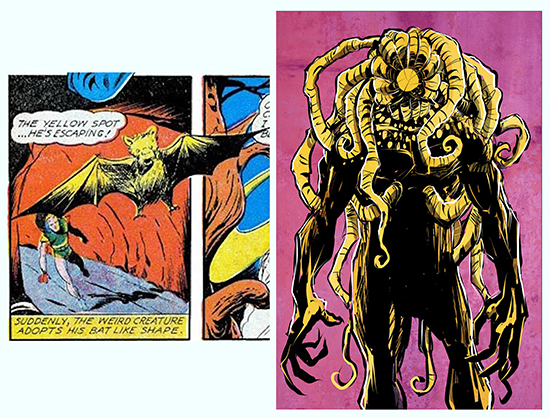
JENNINGS: Exactly. I’m learning so much about these characters; I’m like, who are these characters — and they’re so inventive, and what I love is taking the really silly ones and making them very serious. Like, the Yellow Spot is ridiculous… so I made him into a fear demon kind of thing, because you know, cowardly/yellow. Like, he feeds on fear. It starts out as a little spot, [and enlarges]; he’s an interdimensional fear-parasite. I’ve got a bunch of stuff on my plate — but I really like these characters! What’s really cool about the Jack of Spades is that, he is the Jack of Spades, it’s almost like he’s the card as a superhero.
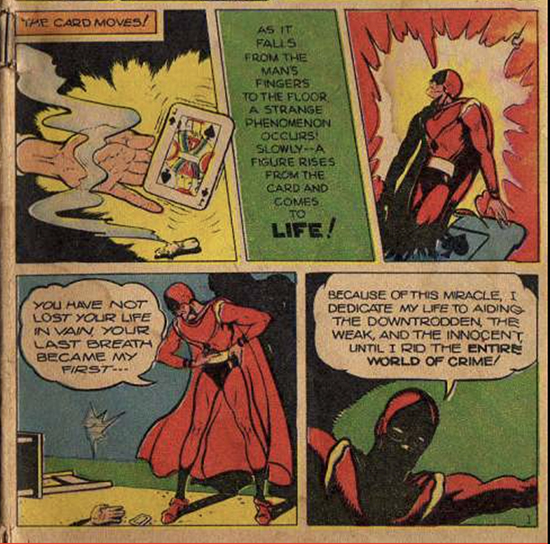
HILOBROW: He’s a totem. There can be mythic gods like Thor who are comic heroes, and this guy is like a slightly lower-echelon divinity because he’s this symbol that everyone is used to seeing.
JENNINGS: What I was thinking about that is, now that we have this mass of casinos, and, like my wife, she plays solitaire, she plays cards every day, to relax from being a mom — and from being my wife, which is probably very stressful! — so, maybe he can jump through playing cards, so he can have this “Deckverse” that he can travel through like The Green in Swamp Thing, and he could pop up in different decks.
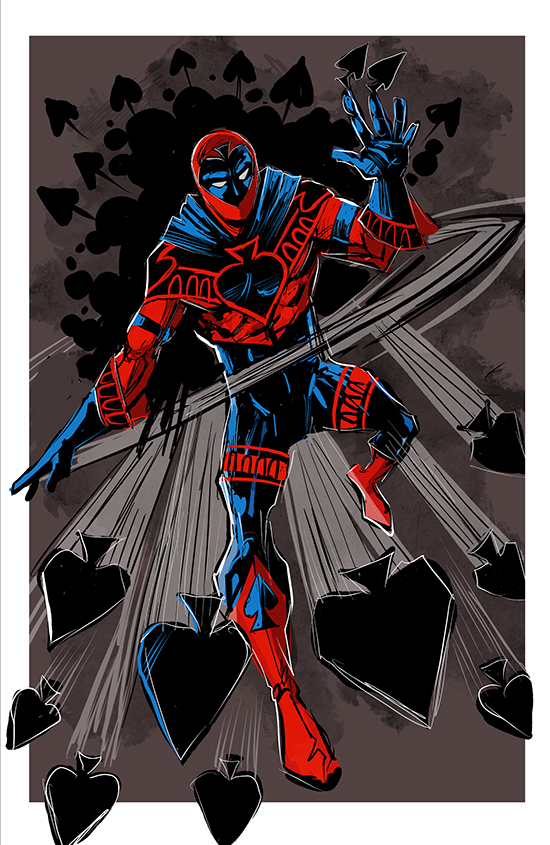
It’s unfortunate what happened with these characters after the Second World War, with all these characters being kicked to the wayside, or discontinued, and people don’t give a damn about ’em, but they’re interesting as hell! There’s some really wild shit that they do — like how did you even come up with this idea? The character idea for Jack of Spades is brilliant; like what were you on that you came up with: “So the actual Jack of Spades comes to life.” “Print it!” [laughter]
The Public Domain HEROES page has become one of my favorite pages. Because there’s this community of people who are really into this one particular data set — essentially what we’re talking about is a data set. You have this one particular data set and people are interacting with it so differently. And their knowledge of it is very specific and interesting; it’s like a bunch of mad scientists studying these artifacts. And trying to figure out, well, how do I interact with this artifact. Because everybody can make stories based off these characters.
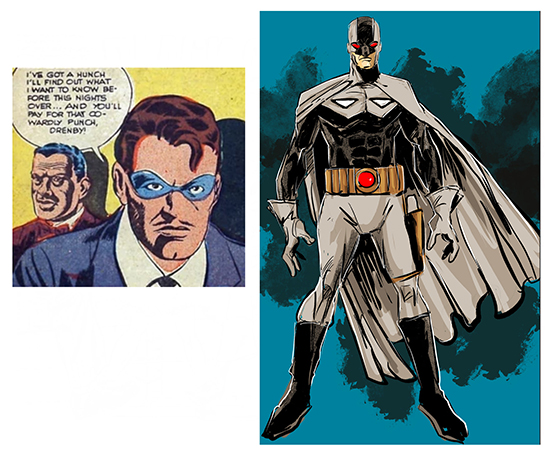
The Gray Mask, I wanna try to use him to fix… you know, the heteronormative white billionaire character, who’s doing good with his money [as a] philanthropist, but he also is, really really heavy into social justice issues for real. I don’t know if [his sidekick] Dove is a man of color or not [he is!], but I was thinking of making him like a Black Alfred, or I guess he’d be like Lucius Fox and Alfred spliced together. So, having a conversation between this extremely privileged white man, who’s also fighting for… I want him to be a really good dude. I’m trying to figure that out, and having conversations between him and this older Black man who came up working-class and survived so much stuff.
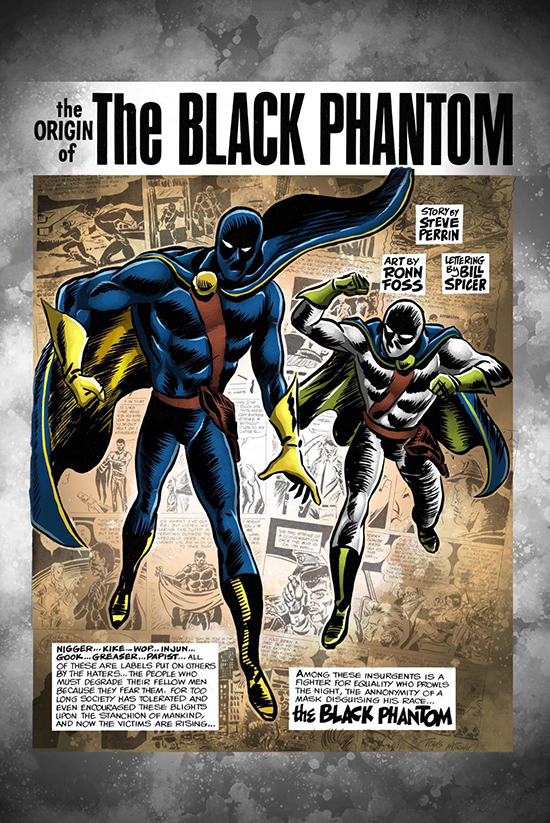
I have this modus operandi of thinking about what I call “Sequential Sankofa,” using the idea of Sankofa, “go back and get it.” I’d been in conversation with the late Steve Perrin, who of course was mostly known for creating RuneQuest, the RPG, and being one of the godfathers of tabletop game design. But before that, he was a student at San Francisco State University, where he created possibly the first, like for real for real Black superhero, in 1964: The Black Phantom. He gets politicized during the 1960s, he’s at San Francisco State where of course there’s a lot of unrest around Civil Rights, and he’s this young, white, impressionable, left-leaning artist type and he’s like, “Yo, I’m really down with this cause, how can I help.” So he wanted to create a Black superhero. He came up with this character Lafayette Jefferson, who goes into the Korean Conflict and he ends up getting the G.I. Bill, goes to school and becomes a really talented engineer. But once he gets out of school he can’t find a job, essentially because of racism. So he ends up becoming a bus driver for a Greyhound-like company. He’s really empowered by the Civil Rights struggle, and he creates this costume and this cape that allows him to become invisible; he has this non-lethal gun that can fire cables and knock-out pellets and all kinds of stuff. And he wants to guard the Freedom Riders. So he takes routes that the Freedom Riders are going and he trails them and protects them while they’re down South. There’s this young white character who’s on the bus with Lafayette. They strike up a conversation, turns out that their politics are actually very much aligned and they become good friends very quickly. So he becomes a character called the Wraith — we’re talking about a Black superhero in 1964 with a white sidekick. Their first — and only — adventure, they fight this white supremacist group called the Brotherhood of the Burning Cross, so essentially, the Klan, and they beat the hell out the Klan in the first 11-, 12-page comic that they did!
So I was talking to Steve about this, and in the middle of us thinking about either building upon his original character, or… he passed away suddenly. So Jim Burrows at G-Man Comics reached out to me because he had talked to Steve, who was telling him he was excited about doing this. So we’re going to do a remastered version, in color; the original was black-and-white. We scanned in the original comics, and we reached out to Steve’s wife, Louise, who gave us her blessing, and we’re gonna work out a deal with her that any moneys that come from this she’ll get her just due. And a family friend has been helping us with going through Steve’s papers to make sure that we’re doing his character justice.
HILOBROW: And you’ll expand with other stories of your own?
JENNINGS: That’s what we’re hoping to do. These characters really mean a lot to me because they’re showing that people were thinking about this stuff earlier than what we’ve been told. These two guys put out — and it was in a zine form, I don’t even know how many copies of the damn thing they made, but that’s the first time we see this. And it’s not ambiguous like, say, Lion Man. I don’t understand why they didn’t go full superhero, I wish I could go back in time and ask them. He has a superhero name, but you made him this kind of Phantom/Tarzan analogue, why didn’t you just go full superhero. Because the superhero idea existed already…
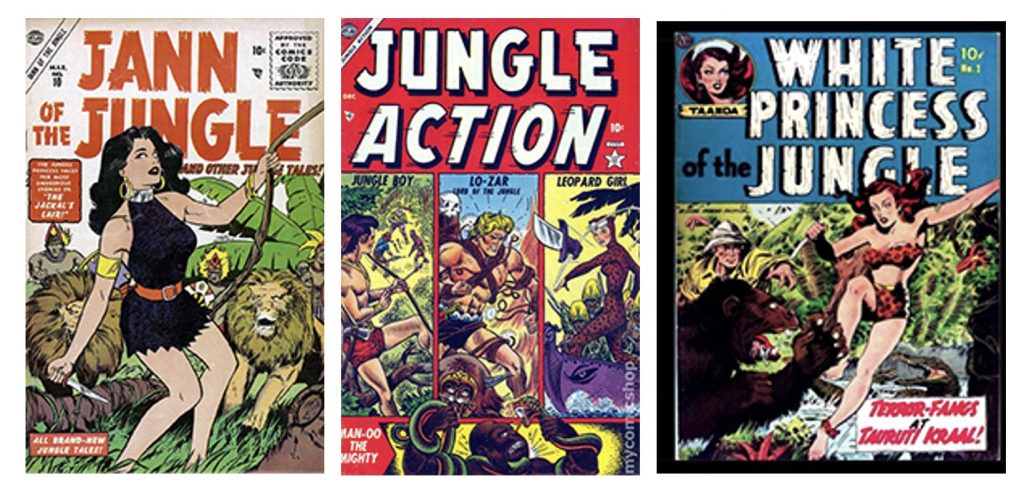
HILOBROW: Well that was, what, 1947? I guess that would already have been when superheroes were dying off as moneymakers… by then there were probably bigger sales for all of that “Jungle Action” crap.
JENNINGS: Good point. Essentially he’s more of a science-fiction character. He’s a Black American scientist who gets sent to Africa by the United Nations to guard a “magical mountain” of uranium.
HILOBROW: It is the most sketched-in of all the concepts in All-Negro Comics, which is funny because it had the potential for being the most iconic. But that’s one of the many things I thought lent such richness — and allowed such richness — to your version of Lion Man, because the original is so sketchy that you could almost think of it as some kind of implanted cover-memory, which goes right along with the theme of your Lion Man, which is that he’s retrieving a memory, reclaiming what really happened. And what really happened is mythic, but that’s the case; like reclaiming the fact that you were a slave descended from kings, that there are times, which those who would bring you down want to bury, that were grander.
JENNINGS: And of course you have characters like one I just came across, Bungleton Green, which is the first African American comic strip in the country, put out by the Chicago Defender, started in the 1920s, and when Jay Jackson takes it over he makes it into a time-travel narrative, like a superhero story and I was like “Whaaaa?” Especially since this is like 1945.
HILOBROW: Important that you brought up newspapers; for a minute I was thinking, I wonder why there never at least developed a Chitlin’ Circuit of publishing, in terms of Black comic books —
JENNINGS: — Okay, again, dude: get out my head! [laughter] I presented a lecture in England at Bournemouth Comic Convention, an international academic comic convention. I came up with a false narrative of what could have happened if All-Negro Comics had continued. In this narrative, what happened in our universe did happen; it was shut down because of racism, it couldn’t find printing-paper for it, whatever. Then what happens is, the second issue is being planned, Orrin C. Evans and his wife go on vacation, and of course they’re using the Green Book to travel. And then he gets the idea, “Wait a minute. This could be a mode of distribution.” So he calls up Victor Hugo Green and says, “Yo, we can print these books up and have them on sale at your Green Book sites.” And Victor Green says “That’s a great idea, we can just use our printer that I use for our books.” So I’m giving this lecture and people are taking notes, really into it. And then I said, “Oh, but didn’t I tell ya—” and I just rip out the carpet right from under them and they get so upset and I said, “Yes, exactly. That’s what we’re talking about, a possible legacy that could have happened and never did.”
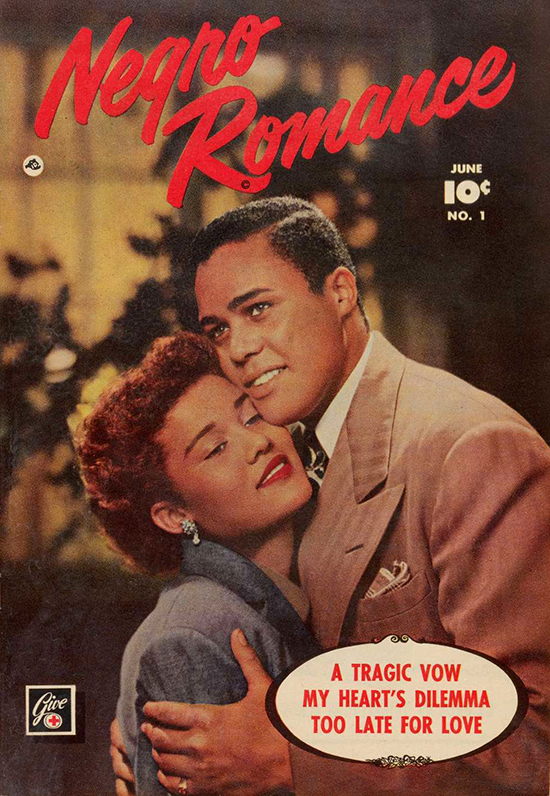
HILOBROW: I’d hope that by now evidence would have come to light if anyone had ever tried that — though it wouldn’t surprise me at all if someone tried it, and the white-owned publishers wanted to control and make money off of anything that could happen like that…like, there was a Negro Romance comic, but put out by one of the big publishers. It could have been about controlling the means of production…though I guess not, since no “mainstream” publisher ever put out a whole segregated line anyway.
JENNINGS: Yes. So I had this idea for a story about a Black woman, who is an avatar for any mistreated comics creators (like Jack Kirby or Bill Finger), and who worked with Jay Jackson, who worked with Jackie Ormes, and ends up creating an entire Black comics universe for this — almost like Atlas Comics? But they’re gonna be Southern, so they’re gonna use the Chitlin’ Circuit, they’re gonna come out of the music industry, and these titles are gonna sell really well. This would start in the 1960s, and she makes up all these characters but they don’t really pay her, of course, what she’s worth, and they lie to her and stuff like that. She ends up dying, but before that she’s like, “Yo. If you don’t do what you say you’re gonna do, Imma make sure that one of these characters I’ve created is gonna come back and exact revenge until you do right by my family.” So she kind of curses them. Essentially the character is going to be a manifestation of this hex, I actually might call it The Hex. I almost had this idea that the characters I’m making up now, are her characters. Because perhaps by then, the 1960s, they would have been public domain, then she could have created these characters based off of older characters — maybe even the thing is, this publisher, they don’t want to publish her original characters, they want to do these public domain characters that people kinda recognize.
HILOBROW: And that presumably they don’t have to pay as much for.
JENNINGS: Exactly. So again, superhero horror-story, but also a history lesson about how artists are treated.
HILOBROW: Memory is the most essential element it seems in these types of stories — which is of course the essence of the concept of Sankofa. Anytime characters — particularly characters who are less well-known — are revived, so often there’s this theme of, they don’t remember who they are (the PD heroes in Dynamite’s Black Cross, Neil Gaiman’s Eternals revival). And of course you use that with great eloquence in the Lion Man story, with the repressed memory…it’s almost like he’s the carrier of an entire people’s repressed memory…kind of like that Great Chronicle.
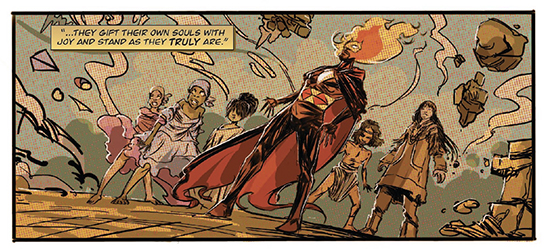
JENNINGS: Right. And I gave him a name, that’s the other thing. He didn’t have a name, he was just “Lion Man.”
HILOBROW: Does he have a last name? I can’t remember at the moment.
JENNINGS: I wanna say Michael Dennison. I have one named Daniel Dennison…[This one is actually Michael Orrin, after the first name of the character’s creator.] There’s a few Lion Men that I’ve created. Daniel Dennison is one of the aspects of Lion Man. My whole thing with nostalgia, playing around with it is, I just really lean into it. I was telling the dudes on the site, about these public domain characters, I’m a really big fan of hip-hop too, so, to me this is the comics version of diggin’ through the crates. You can have a DJ with the same data set, and he’ll mix something totally different. That’s where my head is. Y’know, the same samples, the same beat, same mixing board, and they’ll come up with something totally different because of who they are.
HILOBROW: And it operates in the way that religion often does; the way that there’s both Odin and Wotan, or the Yoruba and Vodou versions of a deity. You were saying something before about how these characters were discarded, and it’s funny to think that there were some characters that otherwise might have been unknown — the Fawcett heroes, the Quality Comics heroes — and they were gobbled up by a corporate giant, DC, and absorbed into its “universe”; all these others were left behind, and it’s almost like exact opposites, one continuum of corporate hegemony and the other of open-source, where there’s this multitude of characters that anyone can use.
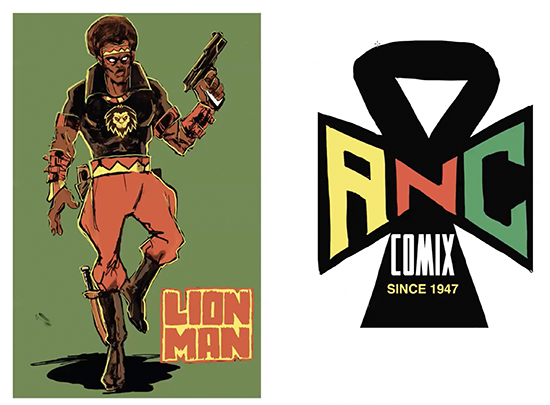
JENNINGS: That’s my 1970s Lion Man [above]. And “ANC,” when you say it, actually spells the work “ankh.” Actually I own the URLs for “All-Negro Comics” and “ANC,” I just bought ’em.
—But here, the Butterfly! [Switches the shared-screen to an image of the early-’70s character from the stillborn Skywald Publications.]
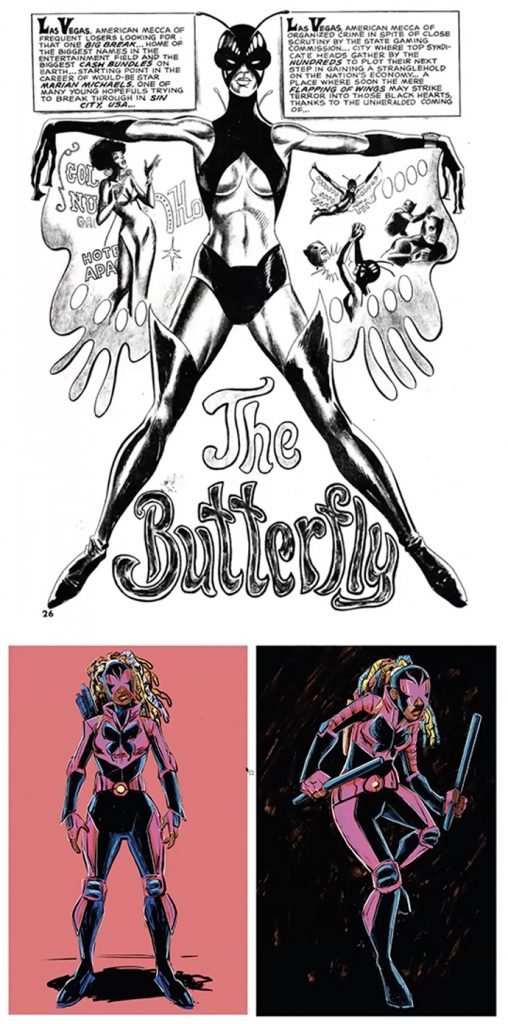
We put together a pitch for how to redesign the Butterfly. This would be the ’80s version, and I actually did a version where she turns into a fucking butterfly. [laughter] This is me and David Brame — no one’s seen this stuff. Trying to get this at Abrams, it’s going to be called “Black Butterflies.” We’re working with a young scholar and writer named Zoe Smith. We’re also working with Larry Fuller [originator of Ebon; full world-rebuilding project here]. I’m really serious about this, updating all the major characters [in Black comics history].
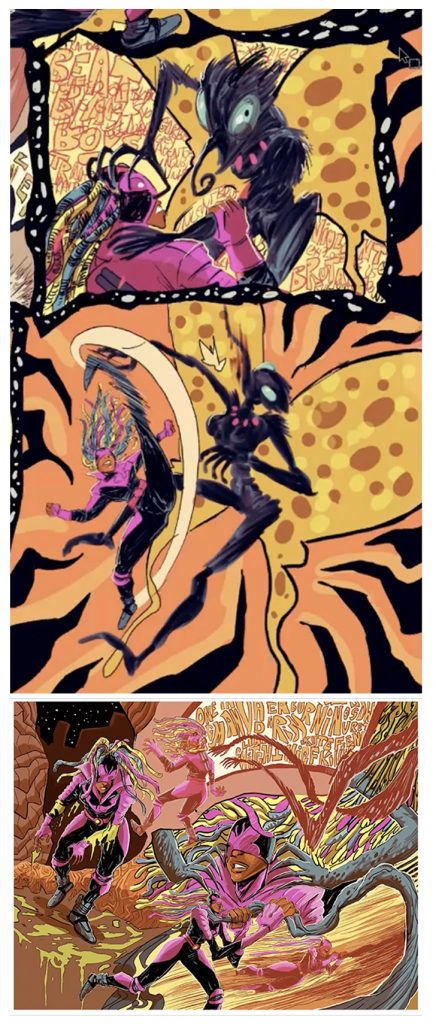
[There were many other stories told, some that I leave out lest their mindblowing new ideas be spoiler’d, some that if I repeated I’d have to be killed before they’re announced and I get to read them. But there are many pages soon to turn, be it the forthcoming historical guide to Marvel’s Black creators and characters, My Superhero Is Black (co-written with Angélique Roché), or the next inventions from MEGASCOPE, including The Eightfold Path (a visionary set of cautionary tales casting Buddhist principles in the form of E.C. Comics-style horror, sci-fi and suspense dramas, coming March 22 from writers Steven Barnes & Dr. Charles Johnson and illustrator Bryan Christopher Moss) and The Keeper (a heartbreaking, horrific and deeply humane metropolitan golem story written by Tananarive Due with Barnes, and illustrated by Marco Finnegan, coming Sept. 27). Not to mention (seriously, they can’t be mentioned yet) the film/TV options and even RPG plans, as well as the ongoing art/sociology/mythmaking exhibitions coming to an educational institution near you (and the current contributions at Carnegie Hall’s Afrofuturism Festival, live and online now!)]
MORE POSTS by ADAM McGOVERN: OFF-TOPIC (2019–2025 monthly) | textshow (2018 quarterly) | PANEL ZERO (comics-related Q&As, 2018 monthly) | THIS: (2016–2017 weekly) | PEOPLE YOU MEET IN HELL, a 5-part series about characters in McGovern’s and Paolo Leandri’s comic Nightworld | Two IDORU JONES comics by McGovern and Paolo Leandri | BOWIEOLOGY: Celebrating 50 years of Bowie | ODD ABSURDUM: How Felix invented the 21st century self | KOJAK YOUR ENTHUSIASM: FAWLTY TOWERS | KICK YOUR ENTHUSIASM: JACKIE McGEE | NERD YOUR ENTHUSIASM: JOAN SEMMEL | SWERVE YOUR ENTHUSIASM: INTRO and THE LEON SUITES | FIVE-O YOUR ENTHUSIASM: JULIA | FERB YOUR ENTHUSIASM: KIMBA THE WHITE LION | CARBONA YOUR ENTHUSIASM: WASHINGTON BULLETS | KLAATU YOU: SILENT RUNNING | CONVOY YOUR ENTHUSIASM: QUINTET | TUBE YOUR ENTHUSIASM: HIGHWAY PATROL | #SQUADGOALS: KAMANDI’S FAMILY | QUIRK YOUR ENTHUSIASM: LUCKY NUMBER | CROM YOUR ENTHUSIASM: JIREL OF JOIRY | KERN YOUR ENTHUSIASM: Data 70 | HERC YOUR ENTHUSIASM: “Freedom” | KIRK YOUR ENTHUSIASM: Captain Camelot | KIRB YOUR ENTHUSIASM: Full Fathom Five | A 5-part series on Jack Kirby’s Fourth World mythos | Reviews of Annie Nocenti’s comics Katana, Catwoman, Klarion, and Green Arrow | The curated series FANCHILD | To see all of Adam’s posts, including HiLo Hero items on Lilli Carré, Judy Garland, Wally Wood, and others: CLICK HERE
